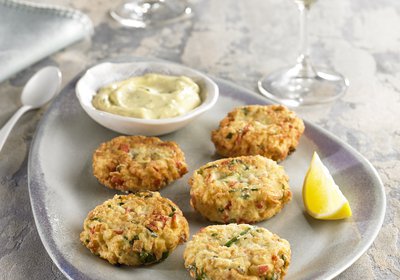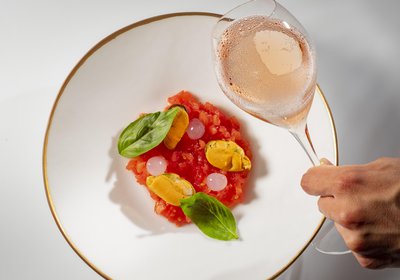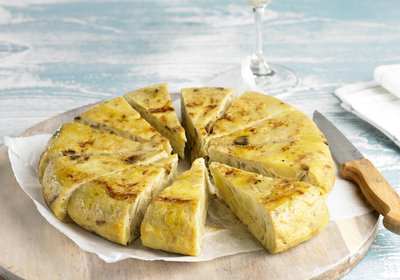Chicken Causa Limeña


Causa limeña is one of the most patriotic dishes in Peruvian cuisine. Quite apart from the patriotic element, it's perfect for serving either cold or at room temperature together with a cava reserva (aged for more than 15 months), that will make absolutely sure you discover all those delicious flavours.
The possible origins of the name of the dish are really interesting. According to culinary historian Rodolfo Tafur, who specialises in Peruvian cuisine, the word "causa" comes from the quechua term "kausay", which means "life", and is also used as a name for potatoes.
That said, it's not altogether clear where the name really comes from, because it's surrounded by stories and legends from its country of origin. When the dish first appeared in pre-Hispanic times, it was a simple a plate of potatoes and slices of ají (a kind of chilli), two key ingredients of rural cuisine in the Andes. In colonial times, different ingredients were added to the potatoes and ají, exactly what these might be, depended on what people had to hand. It's said that in the Republican period the recipe further evolved because a noble lady from a good family in Lima found herself quite unexpectedly faced with having to feed a battalion of soldiers who were celebrating Independence Day. And this is when a boiled egg on top was added as decoration. There's also another story set during the War of the Pacific, when the Peruvian army was up against the invading Chilean forces. These were times of food shortages, and it's said that the women who accompanied the soldiers scrape together the little they had to feed the Peruvian battalions: potatoes, ají, lemon, salt and pepper. After discovering a way of mixing all these ingredients together, the women fed the troops with the rallying cry that would give the dish its name: “¡Para la causa!” (For the cause!).
Whatever the real history of causa limeña might be, this delicious recipe is made with the most typical of the country’s ingredients and is well worth a prominent place in our cookery books.
Ingredients
Instructions
Method
- Wash the potatoes, and boil them in their skins for about 45 minutes.
- Cook the chicken in a pan together with the celery stick, the carrot, 3 or 4 peppercorns, and salt to taste. Boil for 15 minutes.
- While you're cooking the potatoes and the chicken, finely chop the onion, and put it in a bowl with some water to take away some of the bite.
- Finely chop the red chilli into pieces about the same size as the onion, and set it aside in a bowl.
- Hard boil 2 eggs to add to the dish for decoration.
- Slice the avocado thinly, and sprinkle with the lemon or lime juice to stop it from going brown. Set this aside too.
- Cut the carrot into pieces, and reserve this as well.
- When the potatoes are cooked, peel them while they're still warm (it's easier this way), and then grate them so that you can make a purée. Set aside, and keep them at room temperature so that the purée is easier to make.
- Next, pull the chicken breasts apart into strips with your fingers.
- At this point it's time to make the purée with the grated potato, the two spoonfuls of yellow chilli paste, a little salt and a drizzle of oil (not too much, you don't want an oily texture). Once all the ingredients are well mixed, set aside.
- In another bowl prepare the chicken filling, using the chicken, the chopped onion, carrot and red ají chilli. Add a couple of spoonfuls of mayonnaise to the mix, and blend the ingredients together well. Check the seasoning, and if necessary add a bit more salt. Reserve when mixed.
Prepare your causa limeña for serving
- Take a ring-shaped mould, and add half of the potato purée you've just prepared. Press down well, and smooth over so that you have an even layer.
- Next, add a layer of the chicken filling on top of the purée.
- Place the thin slices of avocado that you set aside on top of these first two layers.
- Smooth the rest of the potato purée evenly over the layer of avocados, rather as if it were a cake.
- Turn out of the mould, and you'll see the different layers.
It can be served either cold or at room temperature, as you prefer. If you want to eat it right away, you'll need to add the grated egg and some slices of avocado as decoration, and then you’re ready to serve. On the other hand, if you want to serve it cold, it's best to wait until a few minutes before you’re ready to eat to decorate, so that the avocado keeps its fresh green colour and doesn't have time to go brown.
Ready to go! A Peruvian dish packed with flavour that's great served with "choclo" (Peruvian corn). With or without the Peruvian corn, at the Cava Regulatory Board we recommend accompanying the dish with a cava reserva (aged for more than 15 months) in order to enjoy to the maximum all of the flavours so typical of this dish.
Tips
Choclo Peruano: is a type of sweetcorn typical of the Andes that’s popular in Peru, in much of Latin America and also in Central America. You can either buy it specialised shops, or order it from shops that sell imported fruit and vegetables.










